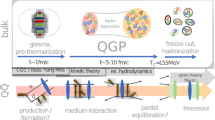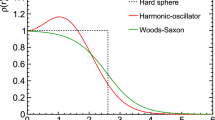Summary
This paper studies a very simplified model of high-energy collisions of strongly interacting particles. It introduces two particles A and B, where A can be regarded as stable and B as an unstable resonance of A. It assumes that all high-energy collisions can be described as taking place between the three channels A+A, A+B and B+B, so that theS-matrix is 3×3. Taking further A and B to be self-conjugate, it enables one to express all consequences of crossing symmetry in terms of the nineS-matrix elements. From these crossing relations and from unitarity it is shown that for each orbital momentumI theS-matrix depends on a single real parametera l which has a simple physical significance in terms of theK-matrix. Constant high-energy cross-sections are obtained whenal is a functiona(ϱ) of the impact parameter. Whena(ϱ) is a smoothly decreasing function ofϱ approaching zero forϱ → ∞ more rapidly than any power ofϱ -1, and has moderately large values for smallϱ, one finds that the elastic differential cross-sections derived from the model agree with the experimental shape of the diffraction peak and are insensitive to the detailed form ofa(ϱ). Ifa(ϱ) is very large for allϱ for which it does not vanish the elastic angular distributions become of the black sphere type. This insensitivity is due to the strong damping imposed by unitarity of theS-matrix whenever theK-matrix elements are appreciate.
Riassitnto
In questo articolo si studia un modello molto semplificato di oollisioni di alta energia fra particelle con interazione forte. Si introducono due particelle A e B, di cui A sipuò considerare stabile e B una risonanza instabile di A. Si suppone ehe tutte le collisioni di alta energia abbiano luogo fra i tre eanali A+A, A+B e B+B, cosicchè la matrice Sè 3 × 3. Supponendo poi che A e B siano autoconiugate, si possono esprimere tutte le conseguenze della simmetria incrociata in funzione dei nove elementi della matriceS In base a queste relazioni incrociate ed all’unitarietà si dimostra che, per ogni impulso orbitalel, la matriceS dipende da un solo parametro realea l che ha un semplice significato fisico in funzione della matriceK. Quandoa l è una funzione a(ϱ) del parametro d’impatto, si ottengono sezioni d’urto di alta energia costanti. Quandoaϱ èuna funzione uniformemente decrescente diϱ, che tende a zero perϱ→ ∞ più rapidamente di ogni potenza diϱ -1, ed ha valori moderatamente grandi perϱ piccolo, si trova ehe le sezioni d’urto differenziali elastiche dedotte dal modello concordano con la forma sperimentale del picco di diffrazione e sono insensibili alla forma dettagliata dia(ϱ). Se a(ϱ) è molto grande per tutti iϱ per cui non si annulla, le distribuzioni angolari elastiohe diventano del tipo a sfera nera. Questa insensibilità è dovuta al forte smorzamento imposto dall’unitarietà della matriceS ogni volta che gli elementi della matriceK sono apprezzabili.
Similar content being viewed by others
References
A series of recent experiments have shown the ratio α=Re T/ImT, T forward scattering amplitude, to be-0.2 to-0.3 at laboratory energies around 10 GeV (πp and pp) and 20 GeV (pp); for a review seeS. J. Lindenbaum’s report at theInternational Conference on High-Energy Physics, (Dubna, USSR, August 1964). The forward dispersion relations predict a slow approach of α to zero at higher energies; see,e.g.,P. Söding:Phys. Lett.,8, 285 (1964) for pp andG. Höhler, G. Ebel andJ. GieseCke:Zeits. f. Phys.,180, 430 (1964) for πp.
K. J. Foley, S. J. Lindenbaum, W. A. Love, S. Ozaki, J. J. Kussel andL. C. L. Yuan:Phys. Bev. Lett.,11, 425, 503 (1963).
L. Van Hove:Bev. Mod. Phys.,36, 655 (1964). As kindly pointed out by Dr.E. F. Peieels, the right-hand side of eq. (4.12) of this paper should read 0.185 instead of 0.213. Also a1 in eq. (4.16) should be changed from 0.86 to 0.885. The uncorrelated model presented in this paper has been applied to pion-proton and protonproton scattering byW. N. Cottingham andE. F. Peieels:The Impact Parameter Expansion of High-Energy Elastic Scattering Amplitudes, Brookhaven National Laboratory preprint (August 1964).
A. Białas:Nuovo Cimento,33, 972 (1964).
A similar model of high-energy collisions has been investigated recently byL. Chang andZ. Koba: to be published. See alsoZ. Koba:Proceedings of the International Conference on High-Energy Physics (Dubna, 1964), to be published. This model is more realistic than ours, but it does not use crossing symmetry and makes no predictions on the shape of the angular distribution for elastic scattering.
L. Van Hove:Phys. Lett.,7, 76 (1963). For an extension of this theorem, to more general asymptotic behayiours, see Sect. 2 of ref. (3).
The definition of the functionE0(x) and the formula (4.4) can be found inG. N. Watson:Theory of Bessel Functions (Cambridge, 1952), p. 78 and p. 156, respectively.
F. Salzman:Phys. Rev.,131, 1345 (1963).
Author information
Authors and Affiliations
Additional information
On leave from Jagellonian University, Cracow, Poland.
Rights and permissions
About this article
Cite this article
Białas, A., Ruijgrok, T.W. & Van Hove, L. A two-particle model for high-energy collisions. Nuovo Cim 37, 608–630 (1965). https://doi.org/10.1007/BF02749859
Received:
Published:
Issue Date:
DOI: https://doi.org/10.1007/BF02749859




